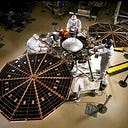Essential Parts of DC Machines
A 4 - pole DC machine (a generator or m) show in fig.1. It consist of four parts
1) Mainly - field Magnets
2) Armature
3) Commutator and brushes
4) Brush gear.
1) The Field Magnets System
It is to provide a uniform Magnetic Field, within which armature rotates.
Electromagnets are preferred in comparison with permanent Magnets on account of its greater Magnetic effect and it's field strength regulation, which can be
Achieved by controlling the exciting ( or magnetizing ) Current.
Fig. 2 Cross section of field System of a DC Generator
Field Magnet consists of four parts
a) Yoke
b) Poles core
c) Pole shoes and
d) Magnetizing coils.
Yoke is meant to provide Mechanical Support and a cover for the entire machine and Carry the Magnetic flux produced by the poles. Pole core is usually of circular section and is used to carry the coils of insulated wires Carrying the existing Current.
The pole shoe acts as a Support to the field coils and spreads out the flux in the air gap. Magnetizing or field coils are to provide, under the various conditions of operation, the number of AT of Excitation required to provide the proper flux through the armature to induce the desired pd.
There are several field constructions adopted according to the type of Excitation.
In such filed, many turns of fine wire are used, in Series field few turns of large
Cross - sectional area are used and in compound field both and series winding are used.
2) Armature Core
It is to rotate the conductors in the uniform Magnetic Field. If consists of coils of insulated wire wound around an iron and so arranged that the Electric Currents are induced in these wires when the armature is rotated in a Magnetic Field.
Fig. 3 Longitudinal view of Armature
The armature Core is made from high permeability silicon - steel stampings, each stamping being separated from its neighbouring one by thin paper or varnish as insulation. The use of high grade steel is made to keep the Hysteresis loss low and to reduce the Eddy Currents in the core.
The stampings or laminations ( 0.4mm to 0.6mm thick ) are used to reduce Eddy Current losses.
3). Commutator
It is from of rotating switch placed between the armature and the external Circuit and so arranged that it reverses the Connections with the external Circuit at the instant of each reversal of current in the armature and thus converts Induced alternating Currents in armature coil into direct currents in the load Circuit.
In case of a DC Motor, a direct current passes through the brushes and Commutator to the armature winding; while it passes through the Commutator, it is converted in to AC so that the group of Conductors under successive field poles Carry current in opposite directions.
Commutator consists of a series of hard drawn copper bars or segments arranged side by side forming a cylinder, and insulated from each other by mica segments 0.5mm to 1mm thick.
4) Brushes and brush Gear
The function of brushes is collect Current from the Commutator and Supply it to the external load Circuit. Brushes are manufactured in a great variety of The composition and degrees of hardness.
Fig. 4 Section through a Commutator
They may be classified roughly as carbon, carbon graphite, graphite, metal graphite and copper. The allowable Current density at the brush contact varies from 5A per square cm in the case of carbon to 23A per square cm in the case of copper.
Copper Brushes are used only for Machines designed for large currents at low voltages.
Fig.5 Brush Holder
Graphite and carbon graphite brushes are self lubricating and are, therefore, widely used.
The brushes are housed in brush- holders mounted on the Brush Holder studs or brackets.
